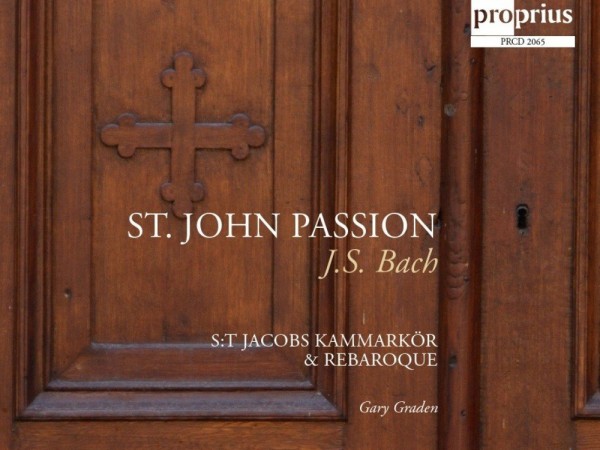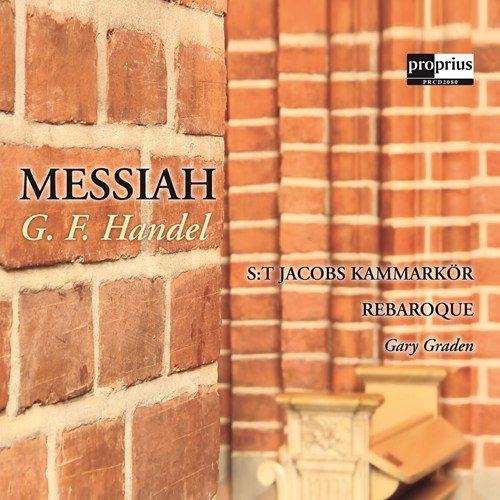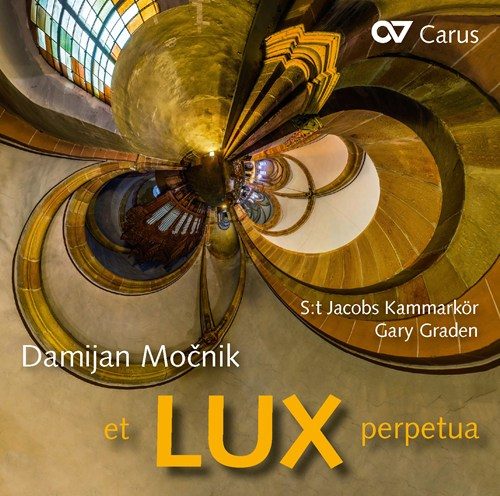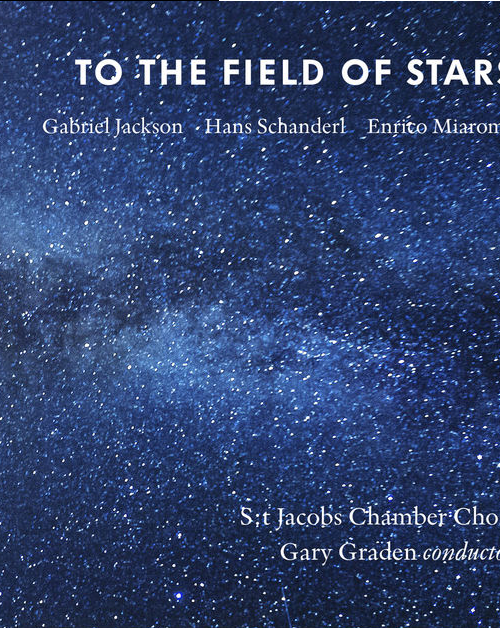 Fanfare Magazine Issue 39:2 (Nov/Dec 2015)
Fanfare Magazine Issue 39:2 (Nov/Dec 2015)
For me—and I suspect I am not alone in this—Bach’s St. John Passion, sterling masterpiece though it is, has generally dwelt under the shadow of the even mightier St. Matthew Passion. This truly astonishing performance banishes all such conceptions; bursting like Athena from the forehead of Zeus, it presents the St. John Passion as an extraordinary vivid and engrossing drama. The manifold strengths of this rendition are such as to leave one almost at a loss where to begin, but the vocal ensemble is as good a starting point as any. The choir of S:t Jacobs Church in Stockholm (and, yes, the peculiar orthography here is not a misprint) has performed the work every year since 1949, and lives and breathes the score as second nature. Its members—here, 10 sopranos, seven altos, nine tenors, and seven basses—have immaculate intonation, balance, diction, and phrasing, and most importantly of all, palpable involvement and commitment to the work as living drama. To cite just one example, the line “Jesum! Jesum! Jesum von Nazareth!” is not just an insistent identification of the sacrificial victim but a cry of savage bloodlust.
Next, there are the soloists, particularly the nonpareil performances of Mikael Stenbaek as the Evangelist and tenor soloist, and Håken Ekenäs as Jesus and for the bass aria “Eilt, ihr angefocht’nen Seelen.” This is quite simply the finest such duo in this work I have ever heard. Stenbaek has a voice that rivals even Fritz Wunderlich for sheer beauty, and exceeds him in this role for interpretive expressiveness and subtlety. Similarly, Ekenäs wields a rich, full bass that imparts a gravitas to his Christus that so notable an interpreter as Dietrich Fischer-Dieskau does not match, and yields nothing to the immortal German baritone in knowing inflection of the text. Indeed their degree of excellence is such that it is, comparatively speaking, a step downward to say that the other three soloists are merely very good and able to hold their own against counterparts in virtually all other recordings. Soprano Jeanette Köhn sings sweetly and expressively; the only thing she lacks is a distinctive timbre to set her apart from numerous other sopranos of a similar caliber. Male alto Mikael Bellini is vocally not on the exalted level of Andreas Scholl (and short of that I prefer female altos in Baroque music) but nevertheless sings with deep feeling. Bass Lars Johanssen has a less refulgent voice in his two arias and comprimario roles than does Ekenäs, but he is quite fine and the noticeable difference between them is most helpful for following the music without text in hand.
Finally there are the contributions of the instrumentalists and conductor Gary Graden. Founded in 1998, REbaroque (again, the off-kilter orthography is correct) is, at least in this recording, a one-performer-per-part ensemble, with a single player each on first and second violin, viola, cello, viola da gamba, double bass, bassoon, lute, and keyboard (organ and harpsichord), and pairs of flutes and oboes for the divided parts for those instruments. While I personally would prefer two or three per part for the violins and violas, I have no quarrel with the superlative results attained here for balance between instrumental and vocal forces; indeed, the bass line has an astounding power and depth that belies the small number of players producing it, and the lutenist in particular brings a rollicking energy to the continuo line that reminds one of a country bluegrass ensemble. Indeed, it is in good part because this performance is constructed from the ground up with special stress on the continuo line, instead of from the top down with a traditional emphasis on the melodic line, that it is so effective.
But what makes this group truly special is its remarkable interpretive expressiveness. For example, I customarily look to the instrumental opening of the introductory chorus “Herr, unser Herrscher” to establish a sense of roiling turmoil, symbolizing the profound conflict of good vs. evil about to unfold. Here, however, a surging swell of the bass notes, overlaid with the piercing tang of Baroque oboes, instead effectively characterizes it as a funeral dirge with lamentation. Another point that rivets one’s attention occurs at the line of recitative where Peter draws his sword and cuts off the ear of Malchus, the high priest’s servant. Right after the word “Schwert” (sword), the instrumentalists play a discord with a cutting edge as sharp as a metal blade. I’ve never heard that effect before, so I went back and listened to several other recordings at that point; the chord is there as well, but no-one else makes anything of it, as is done here and as Bach surely intended. At yet another juncture, at the line where Pontius Pilate hands Jesus over to be crucified, the bass line surges forward, playing a sustained note on the bass with a rasping edge so painful that could almost saw through flesh; that is succeeded by a tense interval of silence, and then the aria “Betrachte, meine Seel” begins with an almost unbearable sense of sweet sadness and devastating repose. I could continue to multiply such instances, but I trust I have made my point clear. This is no ordinary job of conducting; such results occur only when a first-rate musical mind applies itself to a score with complete understanding of the composer’s intentions, total dedication to their realization, and a vivid imagination for how to do so.
The sound quality is stupendous even by digital recording standards. Meticulous care has gone into the physical preparation of this set. A booklet comprising a trilingual German/Swedish/English libretto, bilingual Swedish/English essays and artist bios, a table of contents with track listings (but not individual track timings, my one complaint), and photos, plus a separate digipak containing the two CDs, are housed in an outer clamshell box. The single cover photo used for that outer box and its contents is simple yet unusually attractive. Miracle of miracles, for once the work is sensibly divided, with all of Part I on the first CD and all of Part II on the second, instead of splitting Part II in order to get two discs of more or less equal timing. The more I listen to this set, the more I marvel at it. This set has rightly earned a slot on my 2015 Want List, and should likewise win a place in your collection as well; highest possible recommendation.
James A. Altena © 2015 Fanfare
 Music Web international
Music Web international
Every country has its own traditions in classical music. In Britain no Christmas period is complete without a performance of Handel’s Messiah. In the Netherlands, where I live, the Netherlands Bach Society performs Bach’s St Matthew Passion every year on Good Friday since its foundation in 1921. The present recording of hisSt John Passion also documents an old tradition: this work was first performed in Sweden in 1898 under the direction of the composer Wilhelm Stenhammar. The tradition of performing this passion in St Jacob’s Church in Stockholm goes back to 1945 when a performance took place under the direction of Set Svanholm. He wascantor of this church from 1929 to 1949 and at the same time the leading Wagner tenor of his time. In 1949 the job was taken by Eric Ericson who would become one of the most renowned choral conductors of the second half of the 20th century. In the 1970s he was succeeded by Stefan Sköld; at that time the use of period instruments started. Now it is American-born Gary Graden who is the cantor of this church and continues this rich tradition.
It is understandable that such a tradition is documented on disc. The booklet doesn’t mention any previous recordings; it would surprise me if no previous performance had ever been recorded. One would expect that at least some performance under Ericson’s direction had been recorded. There certainly will be many people who have attended one or more performances who would like to have one of them on disc. However, whether such could compete with the large number of recordings which are available on the international market is a different question.
There can be little doubt about the qualities of the St Jacobs Chamber Choir; its recording of Bach’s motets was given a positive review by Dominy Clements. With its more than thirty singers it produces a remarkably transparent sound and the text is quite easy to follow. That said, this size is not ideal for Bach’s passions. Especially problematic is the balance between choir and instrumental ensemble. REbaroque plays with one instrument per part, and in the tutti episodes that results in them having too little presence.
The turbae are quite dramatic and here one can admire the qualities of the choir. Even at high speed the structure remains intact; the articulation and dynamic accents prevent any of them turning into a big mess. The chorales are less convincing: there is too little attention to the text, and the tendency to hold the closing chord rather long is stereotypical. The opening chorus comes off quite well, but there could have been stronger dynamic accents and the rhythmic pulse could have been more clearly exposed.
The team of soloists has some serious weaknesses. Mikael Stenbaek has an agile voice which is perfectly suited to the part of the Evangelist. The problem is that his interpretation is not very idiomatic. He too often sings legato; there is a lack of that natural accents that every orator uses by instinct in his own language. Stenbaek is not a real narrator. In recitatives the rhythm needs to be treated more freely than is the case here. In the arias I like him more, but even here the articulation should have been sharper.
Some of these features are also present in the singing of the other soloists. Håkan Ekenäss is rather disappointing in the role of Jesus. He doesn’t radiate much authority and his singing is marred by a consistent slight tremolo. Because of that his arias also make little impression. Lars Johansson Brissman is very good in the role of Pilate. Mikael Bellini has a beautiful voice, but is not that powerful. The A part of ‘Es ist vollbracht’ is exquisitely sung, but when it comes to proclaiming Jesus’ victory (Der Held aus Juda siegt mit Macht) he apparently is not able to raise his presence. ‘Von den Stricken’ is not unproblematic either, because his voice is somewhat overpowered by the two oboes. The two soprano arias are the best of this recording. I had never heard of Jeanette Köhn, but I am impressed by the way she sings here. Her articulation and diction are perfect, and she gives fully idiomatic and stylishly convincing interpretations of these arias.
There are some issues which puzzled me. The lute plays a quite prominent role in the recitatives, but I can’t see any historical justification for that. The opening chorus of the second part is preceded by an organ improvisation. Again, I don’t see the reason.
Some tempi are very fast. That goes especially for the tenor aria ‘Ach, mein Sinn’. It is rushed through and as a result has no impact. When the Evangelist recounts that Jesus is scourged Bach uses a musical figure which graphically illustrates the act of scourging, but the tempo is so high that its effect is largely nullified.
To sum things up, this is a very respectable performance, and I can fully understand that people flock every year to the performances in St Jacob’s Church. The dramatic character of this passion is very well conveyed. However this performance from 2011 has a couple too many weaknesses to stand up to the competition of the best.
Johan van Veen
 International Record Review 01 June 2013
International Record Review 01 June 2013
JOHN PASSION – DUNEDIN CONSORT – INTERNATIONAL RECORD REVIEW
The great musical works of art hang on the walls of our aural galleries emanating a deceptive sense of timelessness and immutability as if intentionally created only int he forms in which they are now generally known. In today’s enlightened times we know better, of course. Interpretation and reinterpretation of the original texts lead to different types of performance and to variant forms of the works themselves.
Here we have two contrasting performances of the St John Passion: one, from Gary Graden with the St Jacob’s Chamber Choir and the orchestra REbaroque, a record of a long tradition of performing the work at St Jacob’s Church, Stockholm; the other, from John Butt and the Dunedin Consort, a conjectured performance of 1739. To imagine original context adds yet another interpretative layer, and a number of specialist groups now excel at this sort of musical construction. Butt’s idea is to contextualize the St John Passion, carefully removing it from the gallery wall and setting it in a recreated Vespers service as it might have been celebrated on Good Friday in Bach’s Leipzig. To experience the work as merely part of the liturgy is a salutary reminder of its original devotional purpose and helps to wipe away the marks of semi-secularization to which it has subsequently been subjected.
The organ preludes, motet, congregational hymns and sung prayers that in this reconstruction preface and fallow the two parts of the Passion help to articulate its themes and make musical connections. They support the Passion without distracting from it, and in turn the Passion amplifies and comments on the surrounding texts. For those who wish to observe the complete Passiontide liturgy, more than an hour of additional material is available to download from Linn’s website, including the whole central section of the service with further music and a 40-minute Lutheran sermon from 1720 (in German) and ‘alternative’ sermons from the musical and theological viewpoints of Butt and Richard Holloway. Together with the lengthy essay on the Passion and the reconstruction printed in the booklet, the whole enterprise is ambitious, radical and informative, a truly multimedia project of which the CD recording is just one element.
In the Dunedin performance of the Passion, the choral parts are sung by eight ‘concertists’ and ‘ripienists’ who constitute a strong, tight unit that responds quickly and subtly to the changing moods and functions of the ensemble movements. The distinctiveness of the separate voices is clearly apparent, and in the more dramatic episodes this sharply characterizes theme as a group of baying individuals rather than a single mob. If a downside of the few-voice approach is that the overall effect is flatter, with fewer gradations of scale than are possible with several voices to a part, the benefit must surely be that the intimacy contributes to a more intensely personal communication of the Passion’s message, and that is entirely in keeping with the devotional intent of the reconstruction. All of the soloists are generally outstanding. Nicholas Mulroy’s lithe, sensitive Evangelist is the epitome of narrative clarity and contrasts beautifully with the calming, authoritative richness of Matthew Brook’s Jesus. A particular highlight is ‘Es ist vollbracht!’, the exhausted desolation of its outer sections brought out superbly by Clare Wilkinson’s veiled duskiness, itself a gorgeous counterpart to the drained, parched tone of the viola da gamba.
Over in Stockholm, the St Jacob’s Choir of 30-plus singers is well drilled by, apparently located in some way behind the orchestra, suffers from a distant recorded perspective. The opening exclamatory ‘Herr, unser Herrscher’ is round-edged, lacking the biting grip that is expected, and the effect of the movement is soft-focused and passive. There is also some slackness in the ensemble, particularly in those fast-paced sections of integrated recitative and chorus: ‘Bist du nicht?’, for instance, jumbles in chaotically and takes a second or two to find its feet – dramatically fitting if not musically desirable. In places this must be a consequence of Graden’s choice of tempo: he takes many of the turba choruses very fast indeed, and the often ultra-staccato delivery (of the ‘Kreuzige’ choruses, for example) serves only to exaggerate an almost rabid sense of frenzy. The dramatic pace is breathless. The singers actually manage astonishingly well, but the speeds can be just too rushed to allow the often intricate orchestral parts to shine through. In the arias, too, the soloists are sometimes swamped by the orchestra: in ‘Von den Strikken’ countertenor Mikael Bellini strains to be heard above his rather forward accompaniment. Although mostly well sung, with appropriate sensitivity to mood and meaning, the highest level of refinement can be lacking int he most demanding arias and passages of recitative, as excitement, anger and earnest sentiment give voice to untamed runs and overshot intonation.
Among various different choices made regarding instrumentation the two performances demonstrate contrasting ideas, in particular about the use of continuo instruments. Butt is the more conventional, favouring a simple, discreet group of organ and harpsichord as the harmony instruments with the usual string bass. Graden is bolder adding a plucked string instrument (lute) and, in recitatives that can seem a little overdressed, using all three to underpin different characters as well as dropping in the additional instruments to embellish specific words. Staccato chords in recitatives and bass slides between them also seem too obvious an attempt to ratchet up drama which is already implicit in Bach’s melodic and harmonic writing. Colourful it certainly is, though texturally busy, with more than a few blunders: misinterpreted bass figures, careless misreading, and temporary loss of synchronization between the harmony instrument and its string bass. Graden’s bassoon is unexpectedly, and not altogether happily, prominent: it makes a parody of the cock-crow at Peter’s denial, and dominates the lilting ‘Mein teurer Heiland’ where it plays in tandem with the solo cello – in such a gentle movement, reinforcement of the continuo line isn’t necessary.
For a St John Passion that does things rather differently, both sets oblige. Although the live recording doesn’t present it to an advantage, Graden’s Passion is by and large acceptable if not first-rate; it is certainly enjoyable, partly because it so often seems so impulsively permissive. But it isn’t entirely accurate, and if risks are to be taken they need a sturdier foundation than is provided here. The same accusation could hardly be aimed at the Dunedin Consort’s reconstruction, which, weighed down by both musical and theological scholarship, is more firmly secured. Both the reconstruction and the performance are carefully prepared, historically faithful and immaculately presented, with excellent supplementary, with excellent supplementary material, and on disc the Passion can easily be detached from its liturgical encumbrances if so desired. It may be a musical and liturgical reconstruction of a performance that never actually took place, but for all its presumption and informed guesswork it’s a remarkable project.
Peter Lynan
 Toccata 2014
Toccata 2014

 Newent orchestra 2013
Newent orchestra 2013
J.S. Bach (1685-1750); St John Passion (BWV245), St Jacobs Chamber Choir, c. Gary Graden, Proprius
From the disturbing opening sequence to the final glorious climax, this live performance captures the worshipful nature of Bach’s choral music to the full, as he expresses Christ’s passion and death. There is no doubt as to the greatness of this work.
 Uppsala nya tidning 130130
Uppsala nya tidning 130130
Himmelskt vacker tolkning
St:Jacobs Kammarkör och REbaroque tolkar Bachs oratorium Johannespassionen precis så storslaget som det ska vara, skriver Björn Stenberg
”Och julen varar än till påska. ..”. Kanske att ta i, och dessutom lite för tidigt att börja plocka fram påskpyntet redan nu. Men att lyssna till något så himmelskt vackert som J S Bachs oratorium Johannespassion kan man göra året om, även om det förstås gör sig bäst till den gula högtiden. Verket brukar framföras även i Uppsala men för den som inte kan vänta har S:t Jacobs Kammarkör spelat in tillsammans med REbaroque under ledning av dirigenten Gary Graden. Inspelningen är gjord på hemmaplan i S:t Jacobs kyrka i Stockholm.
Och det låter precis så storslaget vackert som det ska, man kan bli religiös för mindre. Inte för inte har Bach kallats den femte evangelisten, och här förstår man varför.
Björn G Stenberg
 Dagen 130220
Dagen 130220
Mäktigt. Stort. Härligt. Bach´s musik är alltid i tiden. Trots flera hundra år på nacken så känns hans musik alltid närvarande och äkta. Konstigt? Ja, på ett sätt, att gammal musik alltid kan kännas ny. På ett annat sätt inte så konstigt, eftersom viss musik är tidlös. Bach, musikens farfar har ofta fått stå som svar på musikens alla frågor. Johannespassionen tillhör Bach´s absolut mäktigaste verk, trots sin ibland ganska ringa uttrycksform och enkelhet. Som exempelvis i den inledande Chorus. För mig dramatisk men ändå enkel. Stjärnor som Jeanette Köhn, Mikael Bellini och Mikael Stenbaek glänser tillsammans med den just nu hippaste kör vi har, S:t Jacobs kammarkör under Gary Gradens ledning. Verket uruppfördes 1724 i Lepzig och hörs flitigt i påsktid i Sverige.
/Peter Stolpestad
 Tidskriften Evangelium Nummer 3, publicerad 12 mars 2013
Tidskriften Evangelium Nummer 3, publicerad 12 mars 2013
Mångårig passion nu på skiva
Johann Sebastian Bachs Johannespassion framfördes första gången vid vespergudstjänsten på långfredagen 1724 i Nikolaikyrkan i Leipzig, ett år efter att Bach tillträdde tjänsten som Thomaskantor och director musices. Bach reviderade Johannespassionen fyra gånger, sista gången endast ett år innan sin död 1750. Dessa förändringar innebar bland annat att både de inledande och avslutande satserna byttes ut i förhållande till den första versionen. Texten är till största delen hämtad från Johannesevangeliets kapitel 18-19 men det finns även några korta avsnitt från Matteusevangeliet. Förutom bibeltexterna förekommer också texter av B.H. Brockes, C.H. Postel och Christian Weise. I kompositörens dödsruna framgår att Bach efterlämnade fem passioner men endast två av dessa är kända, Johannespassionen och Matteuspassionen (dessutom finns i huvudsak endast texten till Markuspassionen bevarad).
“Och detta är minsann inte vilken musikupplevelse som helst utan ett förstklassigt framförande som förmedlar både starkt engagemang och musikalisk stilmedvetenhet.”
Som formuleras i det välskrivna texthäftet är denna CD-inspelning en dokumentation av en närmare 70-årig tradition i S:t Jacobs kyrka. Denna inleddes av Set Svanholm 1945 och när Eric Ericson tillträdde kantorstjänsten fyra år senare fortsatte traditionen. Verket framfördes inte mindre än 17 gånger under Ericsons 25 år som kantor i S:t Jacobs kyrka. De efterföljande kantorerna Stefan Sköld och nuvarande innehavaren av tjänsten, Gary Graden har fortsatt i samma spår. Alltsedan 1990 har Graden framfört verket tillsammans med S:t Jacobs Kammarkör. De senaste 13 åren har orkestern bestått av REbaroque och konsertmästare Maria Lindal.
Verket har två delar som här delas upp på två skivor; första delen (33:59) och andra delen (72:12), en total durata på drygt 105 minuter. Texthäftet (59 sidor, varav 10 är foton) innehåller information på svenska och engelska om verket och de medverkande. Förutom på originalspråket återfinns hela verkets text även på svenska och engelska.
Med denna inspelning får nu även lyssnaren som inte har möjlighet att fysiskt närvara när verket framförs i S:t Jacobs kyrka chans att dela musikupplevelsen. Och detta är minsann inte vilken musikupplevelse som helst utan ett förstklassigt framförande som förmedlar både starkt engagemang och musikalisk stilmedvetenhet. Både solister, kör, musiker och dirigent är av absolut toppklass. Mina två favoritspår är basarian ”Eilt, ihr angefochtnen Seelen” och altarian ”Es ist vollbracht!”. Här finns det en härlig tyngd i tempovalen som skapar allvar och gravitet. I några satser, till exempel ett par av koralerna, ställer jag mig dock frågan om musiken inte skulle ha vunnit på en något lugnare känsla för att förstärka textens dramaturgi.
S:t Jacobs Kammarkör består av drygt 30 personer, kören är en av vårt lands främsta, den har en meritlista med såväl nationella som internationella framgångar. Tillsammans med dirigenten Gary Graden, solister och REbaroque har de gjort inspelning som jag varmt kan rekommendera. Att det dessutom är en liveinspelning förstärker det genuina i helhetsupplevelsen. Köp den!
Karin Nelson
 Customer Reviews
Customer Reviews
Anyone who has listened to some of Suzuki’s CDs of Bach’s cantatas cannot fail to be impressed by this performance of the St John Passion, one of Bach’s masterpieces. Here there are no affectations; the music is played in an entirely ‘straight’ manner which allows it to speak for itself, in a deeply moving recording. Having listened to other recordings, this is simply the best – whilst the soloists may not be household names, this will mean that they treat the music as it should be, and not as if it were opera. The choir are in sparkling form, allowing the drama inherent in the music to speak for itself, and whlist Suzuki’s pacing may not be vary slightly from the received norm, it seems entirely right. This is the recording to buy.
Outstanding playing and singing – you can see why this is the top rated recording. Sound quality also very good indeed.



